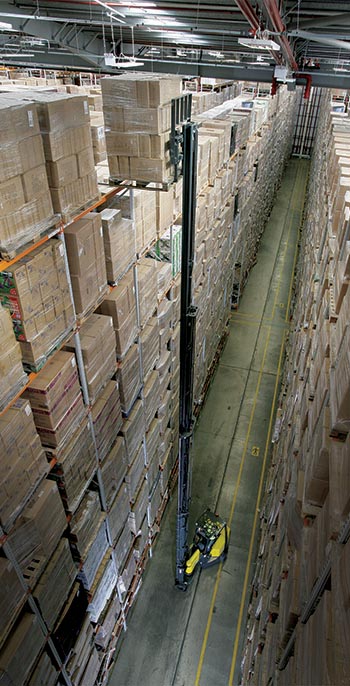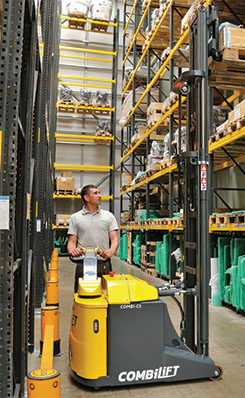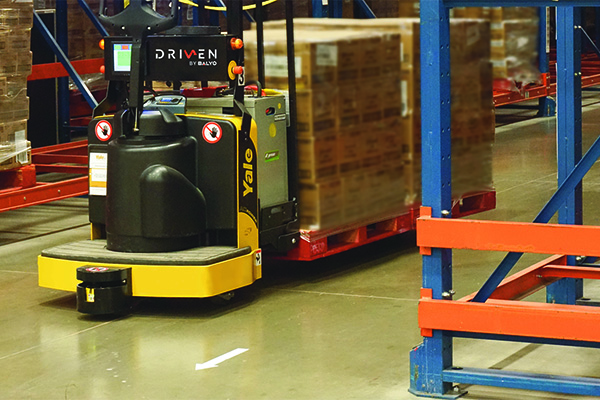The brave new world of buying lift trucks
The old days of buying a lift truck as a commodity unrelated to other materials handling equipment purchases are going away. Rapidly. It’s all because of fundamental shifts in how distribution centers operate—and new technology, of course.
There’s an important shift underway in the lift truck buying process. In a word, lift truck purchases are becoming more holistic.
Did you really just read that? Did the words holistic and lift truck appear in the same sentence? That’s a “yes” on both counts. More importantly, this trend is worth factoring into your lift truck fleet decision process going forward because the leaders are already doing it.
“There is a need for a continuous, regular change in the configuration of fleets,” says Mick McCormick, vice president of robotics and automation at Yale Materials Handling. And that dynamic shift within fleets is due to fundamental changes in facilities and how they work, as companies respond to labor needs and speed to markets.
Meanwhile, the configuration of distribution centers in particular is shifting, explains John Krummell, CEO of rack manufacturer Advance Storage Products. In a Modern “60 Seconds With” interview in April of this year, Krummell said 30-foot tall rack is being overshadowed by common use of 45-foot rack. “Customers are also de-densifying their rack. It’s a combination of an increasing number of SKUs, but a lower inventory per SKU, and users want less density and more selectivity.”
To begin, distribution itself seems to be changing almost daily. While many long for the lost world of pallet loads, they must now accommodate eaches as well as returns. As inventory units within the plant and warehouse change, there’s also an increasingly rapid proliferation of SKUs and a shorter duration of those SKUs in the facility itself. And that doesn’t even bring in the shorter product life cycles to meet constantly shifting customer interests, needs and demands.
The result is a different DC layout if not new distribution methodologies. “These are material changes in how people do business. And to accommodate that, they are taking a holistic look at the DC,” says Mike Romano, president and CEO of Toyota Advanced Logistics NA.
 As part of that shift, Romano says that lift truck buying is leaving its buying silo. As automation, including automated lift trucks, increases in facilities, all equipment is increasingly being viewed as part of a system. “Trucks are now part of a bigger picture. No more silos. Customers are changing their view of trucks. As a result, lift trucks will be 100% included as a holistic part of any materials handling system going forward,” Romano asserts.
As part of that shift, Romano says that lift truck buying is leaving its buying silo. As automation, including automated lift trucks, increases in facilities, all equipment is increasingly being viewed as part of a system. “Trucks are now part of a bigger picture. No more silos. Customers are changing their view of trucks. As a result, lift trucks will be 100% included as a holistic part of any materials handling system going forward,” Romano asserts.
Changes in the trucks
All of that is at the highest level of the lift truck buying process. Drilling down a bit, let’s start with safety.
“The biggest driver in the United States and the rest of North America is safety,” says Martin McVicar, Combilift’s managing director.
“There are many ways that safety can be improved with technology such as telemetry, and that is driving buying behaviors,” says Martin Boyd, vice president of product planning and solutions at Hyster.
Telemetry is another factor in buying decisions. In fact, sensing technologies continue to proliferate. Raymond says that in 2010, sensors monitored only 10 critical operating conditions. Today, that number is 72. In other words, lift trucks are becoming a rolling database. The aim is to operate lift trucks more safely, efficiently and effectively.
“Telematics is important beyond day-to-day operation,” says Michael Heyden, Toyota’s national manager of aftermarket sales. “It is becoming essential to fleet replacement strategies, not to mention decisions to expand or shrink fleets,” he adds.
There’s also the matter of labor needs and availability affecting lift truck buying. Enter automated lift trucks and their interaction with other automation including automatic guided vehicles and autonomous mobile robots.
“Clearly, customers are investing in robotic lift trucks to increase their workforce flexibility,” says McCormick of Yale.
This is just the tip of the iceberg in changing lift truck buying practices. The underlying story, says UniCarriers’ director of corporate planning Mark Porwit, is customization. He and others will tell you about 20 or more custom features that can be standardized on lift trucks to meet specific customer requirements. “This goes well beyond paint color, ranging from mast configuration to USB ports,” says Porwit. Even power systems such as hydrogen fuel cells and lithium ion batteries are now part of the discussion.
Clearly, lift trucks are leaving their commodity moniker behind, and generating quite a different discussion at the buying table these days.
The value of safety
As Boyd at Hyster says, “a safe operator is a productive operator.” That is not a new mantra. However, new technologies in the automotive sector are making lift truck safety technology discussions a high priority for fleet buyers and operators alike.
Obstacle detection and pedestrian awareness innovations are two key areas today.
“There is broad investigation across the lift truck industry as to how sensing technology and camera innovations can be applied to the industrial environment,” says Boyd. He also notes that customers now ask for these innovations to help improve safety in their specific workplace environments. “In fact, this technology pull from customers is starting to affect their buying behavior.”
Beyond obstacle and pedestrian protection, McVicar of Combilift cites new technology to protect operators against overloading trucks.
As he says, “there is just too much math for a typical operator to avoid vehicle overloading.” Instead, strain sensors, advanced load movement indicator lights and alarms notify operators when a truck is overloaded, off center or lifting too high for the equipment, McVicar adds.
Robotic lift trucks move in
Robotic lift trucks are potentially the most influential technology in lift truck buying decisions going forward. They are not all that popular yet. However, “the shift in technology will likely become evident during the next three years,” says McCormick.
He is not expecting robotic lift trucks to become dominant in that time frame. However, McCormick expects robotic lift trucks will be upward of 20% or 30% of truck purchases that soon.
To begin, McCormick says, robotic lift trucks directly address the labor shortage. They also offer the flexibility to operate autonomously or with an operator if needed. That combination, McCormick says, goes a long way to reducing the total cost of ownership of each truck.
Boyd of Hyster agrees saying, “the cost of the operator is a huge part of total cost of ownership. And when you come down to it, total cost of ownership is driving much of the lift truck buying decisions today.”
“Robotic lift trucks are a key area to the developing systems approach in lift truck buying,” says Toyota’s Heyden.
Occupying much the same space here are not just robotic lift trucks and automatic guided vehicles (AGVs) but autonomous mobile robots (AMRs).
They each have their own profile. Many robotic lift trucks physically look like their namesake as AGVs look much like they have for 40 years. AMRs look more like bots used in an Amazon warehouse, but not always.
They even use similar guidance technologies including LiDAR (light detection and ranging) systems. These systems map a facility for vehicle guidance systems. Camera-based systems also guide robotic lift trucks.
Ensuring that all vehicles avoid obstacles, including each other, inherently brings the system approach into the lift truck buying and usage equation.
Rolling databases
All lift truck suppliers have answered the call for more information collected by lift trucks and shared across the enterprise.
The basics here include truck utilization, impact to trucks and OSHA checklists. But as suppliers add more sensors to trucks, more data is collected. This allows managers to identify more data points and connect them to better evaluate effective truck usage down to specific operators, says McCormick.
Beyond operating data, telematics enables improved fleet management all the way through the buying process, adds McCormick.
Having the right data makes it much easier for buyers to right-size fleets without guessing, not to mention pinpointing the sweet spot to replace trucks, says Combilift’s McVicar.
There’s also the matter of maintenance. Telematics, explains Boyd, opens the door to predictive maintenance. Unlike preventive maintenance which pre-schedules repairs, predictive maintenance initiates repairs only when necessary based on data collected from truck sensors. “This practice is very limited today, but is absolutely going to come along,” continues Boyd.
Feature customization
Take all of what has already been described, and it is clear that lift truck customization is becoming more possible than ever.
 Some of the more common customizations include scales, scanners and cameras, says Porwit of UniCarriers. Electrical outlets that provide power to three-pronged extension cords are even part of the mix. Some suppliers report that as many as half of their orders come with customization requests.
Some of the more common customizations include scales, scanners and cameras, says Porwit of UniCarriers. Electrical outlets that provide power to three-pronged extension cords are even part of the mix. Some suppliers report that as many as half of their orders come with customization requests.
A developing one is power source. The electric or internal combustion engine continues to be the top-line distinction. But the power source for electrics is now in play, says Boyd. The leading contenders to replace lead-acid batteries are hydrogen fuel cells and lithium-ion batteries, he adds. Lithium ion “has the bigger wave behind it,” Boyd says. While still in the early stages of development, lithium ion enables operations to use only one battery per truck, eliminates acid spills and charging rooms, can cut charging time in half and provides at least twice the lifetime of lead acid batteries.
The upshot of all these developments is simple. The next time your facility needs to expand or replace lift trucks, don’t ask the same questions or use the same process as the last time around—unless you want to be left behind the curve.













